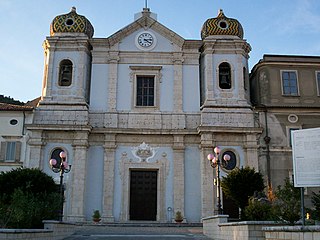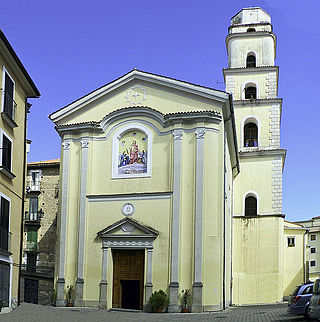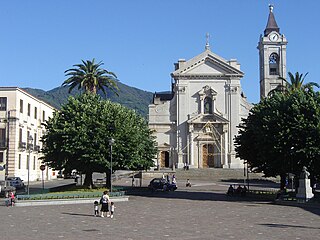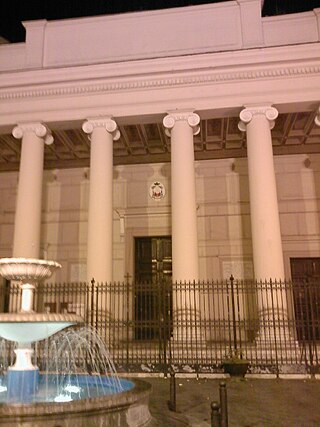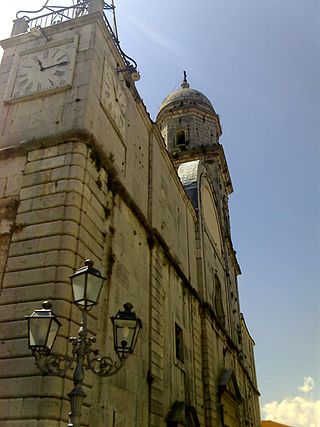History
| | This section needs expansion. You can help by adding to it. (September 2022) |
Bishops of Pesto (Paestum) are known by the end of the sixth century. [3] All of the dioceses of Lucania, except Paestum, appear to have been fatally damaged by the appearance of the Arian Lombards at the end of the 6th century. [4] Paestum was attacked in the early 10th century by the Saracens, who fortified the area of Agripoli, which had once been the citadel of the Greek colony and then the Roman colony of Paestum. The city was burned. The inhabitants fled into the mountains, where they built the town that came to be called Capaccio. [5] In 1080, the town of Pesto was devastated by the Norman Duke Robert Guiscard, and nearly deserted. [6]
Ecclesiastically, Pesto becomes associated with Capaccio by 967, when Pope John XIII wrote to "reverendissimo confratri nostro, Petro Paestano Episcopo, quae Caput-aquis dicitur. [7]
The episcopal palace was in Capaccio, but the bishops also had residences in Sala, Novi, and Diano. [8] The episcopal palace at Diano, purchased and improved by Bishop Francesco Brancaccio, was dedicated in 1629. [9] In 1704, the bishop resided in S(c)ala, and pontificated in the church of S. Pietro. [10]
In 1583, a diocesan synod was held, presided over by the Vicar General Silvio Galasso, in the absence of Bishop Lorenzo Belo, who was ill. [11] Bishop Pedro de Mata (1611–1627) held a diocesan synod in 1617. Bishop Francesco Maria Brancaccio (1627–1635) held a diocesan synod in 1629. [12] On 12–14 December 1649, Bishop Tommaso Carafa (1639–1664) presided at a diocesan synod held in Laurino. [13]
The diocese of Capaccio had a seminary, located in Diano; and three episcopal colleges (high schools), in Novi, Sicignano, and Capaccio. [14]
After Napoleon
Following the extinction of the Napoleonic Kingdom of Italy, the Congress of Vienna authorized the restoration of the Papal States and the Kingdom of Naples. Since the French occupation had seen the abolition of many Church institutions in the Kingdom, as well as the confiscation of most Church property and resources, it was imperative that Pope Pius VII and King Ferdinand IV reach agreement on restoration and restitution.
1818
A concordat was finally signed on 16 February 1818, and ratified by Pius VII on 25 February 1818. Ferdinand issued the concordat as a law on 21 March 1818. [15] The re-erection of the dioceses of the kingdom and the ecclesiastical provinces took more than three years. The right of the king to nominate the candidate for a vacant bishopric was recognized, as in the Concordat of 1741, subject to papal confirmation (preconisation). [16] On 27 June 1818, Pius VII issued the bull De Ulteriore, in which he reestablished the metropolitan archbishopric of Salerno, with five suffragan dioceses, including Capaccio. [17]
1853
The diocese, as it had grown over the centuries, had become extremely large in geographical extent, and, as the population grew as well, it became much more difficult to administer. In 1848, the inhabitants numbered some 182,000. [18] Discussions on dividing the diocese had already begun in the reign of Pope Gregory XVI, [19] division of assets and relocation of facilities being of prime consideration. Progress was interrupted by the revolutions of 1848, and the deposition of the pope and creation of the Roman Republic. In addition, Bishop Gregorio Fistilli had resigned on 26 September 1848, [20] leaving the diocese of Capaccio without a bishop from 1848 to 1853. [21] By April 1850, however, Pius IX was back in Rome, and by 1853 general agreement had been reached with Ferdinand II of the Two Sicilies and with representatives of the communities in the diocese of Capaccio. [22] The diocese would be divided into two separate dioceses, one at Diano and the other at Vallo.
On 16 July 1853, Pius IX signed the bull "Cum propter justitiae dilectionem," establishing the diocese of "Caputaquensis et Vallensis" (Capaccio e Vallo). The new diocese was to be a suffragan of the archdiocese of Salerno. [23] The parish church of S. Pantaleone was elevated to the status of cathedral, and a Chapter was created consisting of two dignities (the Archdeacon and the Archpriest) and twelve canons, a Canon Theologus and a Canon Penitentiary, and six mansionarii. [24]

